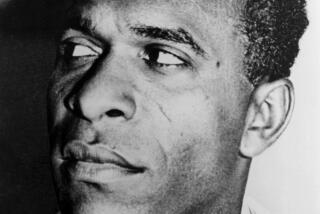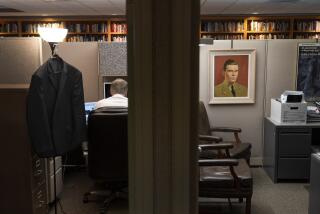‘The Harvard Psychedelic Club’ by Don Lattin
The Patience Stone
Atiq Rahimi
Translated from the French by Polly McLean
Other Press: 160 pp., $16.95
Books have many incarnations. Some come back as plays or movies. If they have questionable karma, they come back as paperback remainders or Saturday morning cartoon shows. “The Patience Stone” would make a fabulous one-woman play. It is set in a bedroom in Afghanistan, where a woman has watched over her husband for 16 days. He is comatose, with a bullet in his neck. The woman changes the bag of fluids and adjusts the tube that keeps him alive. She breathes alongside him. Outside, the sounds of tanks, gunshots, screaming and, most terrifying, silence. Inside, her two frightened daughters call to her from the hallway. A Koran lies on the kilim. As she tries to keep her husband alive, the woman rages against men, war, culture, God. She confesses many secrets; things that have been done to her and things she has done. In confessing, she feels more free, if such a thing were possible in that room, in that war. Her husband’s body reminds her of the legend of the patience stone, a stone that hears all confessions until it explodes. “One should never rely on a man who has known the pleasure of weapons!” she berates herself. “You men, you’re all cowards!” All the times she has betrayed herself, just to stay alive. “The Patience Stone” is perfectly written: spare, close to the bone, sometimes bloody, with a constant echo, like a single mistake that repeats itself over and over and over.
The Harvard
Psychedelic Club
How Timothy Leary, Ram Dass, Huston Smith, and Andrew Weil Killed the Fifties and Ushered in a New Age for America
Don Lattin
HarperOne: 256 pp., $24.99
It does seem remarkable that in the fall of 1960, these four men fell into orbit on the Harvard campus: Timothy Leary, a research psychologist; Richard Alpert (Ram Dass), a psychology professor; Andrew Weil, a student of botany and later medicine; and Huston Smith, a professor of philosophy at the Massachusetts Institute of Technology. This is only the core cast -- Aldous Huxley, Allen Ginsberg and others play supporting roles. It may, however, be stretching things to say that these four horsemen created the mind-body-spirit movement in the United States. Don Lattin tells the story with panache (blinded now and then by kismet, but hey), making no bones about the fact that he is writing narrative nonfiction, based on interviews and secondary sources. Lattin re-creates scenes and dialogues. He names his characters the Seeker (Alpert), the Teacher (Smith), the Trickster (Leary) and the Healer (Weil) and weaves his story around them. The four began as “career-driven, linear-thinking intellectuals,” were undone (largely by consciousness-expanding drugs) and reborn as leaders and co-conspirators in a Jumanji game with American culture. Lattin’s fascinated by these men, but he’s also a fierce judge of their trespasses and their lapses from authenticity. (So we’re glad to have him tell the story.)
Alpert was overwhelmed by his own insecurities, Leary seduced by excess, Weil (who wrote a damaging exposé in the Harvard Crimson of Leary and Alpert more than 40 years ago) comes out as a canny businessman who has done much to make mainstream medicine more honest, and Smith emerges as the hero of the story: “All four members of the Harvard Psychedelic Club dedicated their lives to the study of the human consciousness. What separates Huston from the pack is his understanding that the real test of a person’s spirit is the way they live their lives. It’s what happens after the ecstasy.”
I Used to Be Somebody
Bob Wynn as told to Tom O’Connell & Johanna Miller
Tate Publishing: 250 pp., $14.99
This book crossed my desk with a self-deprecating letter in which the 77-year-old author doubted very highly that anyone actually cared about his 40-plus years producing and directing television shows and extravaganzas for NBC, ABC, CBS and PBS. A beautiful air of indifference to his own legacy wafts through much of the book (he’s human, after all, and allows himself a bit of record-straightening), setting it apart from so much of the self-mythologizing that poisons ex-executives in any field. This lightness adds to the glamour and the nostalgia for those bad old days with Sammy Davis Jr., Danny Thomas, Bob Hope and many others. Reading “I Used to Be Somebody” is so much like one of those evenings that reminds you of why you love Los Angeles. You end up at a dinner, sitting next to someone who tells the most wonderful stories. By the end of the evening, you feel, inexplicably, like dancing.
Salter Reynolds is a critic in
Los Angeles.
More to Read
The biggest entertainment stories
Get our big stories about Hollywood, film, television, music, arts, culture and more right in your inbox as soon as they publish.
You may occasionally receive promotional content from the Los Angeles Times.






